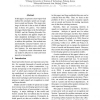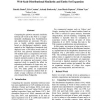EMNLP
2009
13 years 10 months ago
2009
User clicks on a URL in response to a query are extremely useful predictors of the URL's relevance to that query. Exact match click features tend to suffer from severe data s...
EMNLP
2009
13 years 10 months ago
2009
This paper presents a new method of developing a large-scale hyponymy relation database by combining Wikipedia and other Web documents. We attach new words to the hyponymy databas...
EMNLP
2009
13 years 10 months ago
2009
A significant portion of the world's text is tagged by readers on social bookmarking websites. Credit attribution is an inherent problem in these corpora because most pages h...
EMNLP
2009
13 years 10 months ago
2009
The recent availability of large corpora for training N-gram language models has shown the utility of models of higher order than just trigrams. In this paper, we investigate meth...
EMNLP
2009
13 years 10 months ago
2009
EMNLP
2009
13 years 10 months ago
2009
This paper presents a parse-and-paraphrase paradigm to assess the degrees of sentiment for product reviews. Sentiment identification has been well studied; however, most previous ...
EMNLP
2009
13 years 10 months ago
2009
Recent syntactic extensions of statistical translation models work with a synchronous context-free or tree-substitution grammar extracted from an automatically parsed parallel cor...
EMNLP
2009
13 years 10 months ago
2009
In this paper, we present a semi-supervised method for automatic speech act recognition in email and forums. The major challenge of this task is due to lack of labeled data in the...
EMNLP
2009
13 years 10 months ago
2009
In the early days of email, widely-used conventions for indicating quoted reply content and email signatures made it easy to segment email messages into their functional parts. To...
EMNLP
2009
13 years 10 months ago
2009
Computing the pairwise semantic similarity between all words on the Web is a computationally challenging task. Parallelization and optimizations are necessary. We propose a highly...








